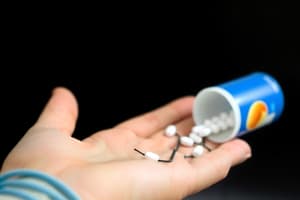Podcast
Questions and Answers
What is the term for the minimum concentration of a drug required to produce an effect at a specific location?
What is the term for the minimum concentration of a drug required to produce an effect at a specific location?
- Minimum Effective Concentration (MEK) (correct)
- Optimal Therapeutic Dose (OTD)
- Minimum Toxic Concentration (MTC)
- Maximum Effective Concentration (MEC)
Which factor is critical in determining the amount and application site of a drug to ensure it reaches its target?
Which factor is critical in determining the amount and application site of a drug to ensure it reaches its target?
- Bypassing the need for the drug to be present at a certain concentration.
- Administering the drug in the largest possible quantity to overwhelm any barriers.
- Ensuring the active substance reaches the place of effect at the MEK. (correct)
- Achieving the maximum tolerated dose regardless of location.
What two primary factors determine the classification of drug application routes?
What two primary factors determine the classification of drug application routes?
- The purpose for targeting the drug and the condition of the application site. (correct)
- Drug color and place of manufacture.
- Drug taste and patient preference.
- Patient age and drug cost.
What is a key characteristic of local drug application?
What is a key characteristic of local drug application?
Which of the following is an example of a local application route for drugs?
Which of the following is an example of a local application route for drugs?
For what types of conditions is epidermal drug application most suitable?
For what types of conditions is epidermal drug application most suitable?
What is the primary characteristic of drugs used via the epidermal route in terms of absorption and systemic effects?
What is the primary characteristic of drugs used via the epidermal route in terms of absorption and systemic effects?
Where is an intracutaneous drug application administered?
Where is an intracutaneous drug application administered?
What type of tests commonly utilize intracutaneous drug application?
What type of tests commonly utilize intracutaneous drug application?
What critical requirement must ophthalmic preparations meet?
What critical requirement must ophthalmic preparations meet?
Which conditions utilize intranasal drug application?
Which conditions utilize intranasal drug application?
What types of drugs are commonly administered via the intranasal route?
What types of drugs are commonly administered via the intranasal route?
What is a possible effect following intranasal drug administration?
What is a possible effect following intranasal drug administration?
For what purpose is buccal drug application primarily used?
For what purpose is buccal drug application primarily used?
Which area benefits from medications applied via the external ear canal?
Which area benefits from medications applied via the external ear canal?
What localized area does intrathecal drug administration target?
What localized area does intrathecal drug administration target?
In which emergency situation might intracardiac drug administration be utilized?
In which emergency situation might intracardiac drug administration be utilized?
When are injections into the abdominal cavity via the intraperitoneal route performed?
When are injections into the abdominal cavity via the intraperitoneal route performed?
What types of conditions do intraarticular injections treat?
What types of conditions do intraarticular injections treat?
What therapeutic agents are commonly delivered via intraarticular injection?
What therapeutic agents are commonly delivered via intraarticular injection?
In what situations is rectal and colonic drug application typically used?
In what situations is rectal and colonic drug application typically used?
After a cesarean section, what is the purpose of intrauterine injections of oxytocic hormone?
After a cesarean section, what is the purpose of intrauterine injections of oxytocic hormone?
How are medications administered via the intravaginal route typically formulated?
How are medications administered via the intravaginal route typically formulated?
What is the primary purpose of using spermicide drugs intravaginally?
What is the primary purpose of using spermicide drugs intravaginally?
What is a key characteristic of the enteral route of drug administration?
What is a key characteristic of the enteral route of drug administration?
Which of the following is a key factor of parenteral drug administration?
Which of the following is a key factor of parenteral drug administration?
How does transdermal drug application work?
How does transdermal drug application work?
What physical state must lipophilic drugs be in to be effectively administered via inhalation?
What physical state must lipophilic drugs be in to be effectively administered via inhalation?
What anatomical structure facilitates drug absorption during inhalation?
What anatomical structure facilitates drug absorption during inhalation?
What is a significant limitation of oral drug administration?
What is a significant limitation of oral drug administration?
In which scenarios is sublingual drug administration particularly useful?
In which scenarios is sublingual drug administration particularly useful?
What is a common characteristic of drugs administered sublingually?
What is a common characteristic of drugs administered sublingually?
How is drug absorption achieved during rectal administration?
How is drug absorption achieved during rectal administration?
What feature classifies parenteral administration?
What feature classifies parenteral administration?
What is a major advantage of intravenous drug administration?
What is a major advantage of intravenous drug administration?
What characterizes an intramuscular injection site?
What characterizes an intramuscular injection site?
Flashcards
MEK (Minimum Effective Concentration)
MEK (Minimum Effective Concentration)
The concentration of a drug required to have an effect in a certain place.
Local Application
Local Application
Application of drugs where the drug is intended to affect the body surface.
Systemic Application
Systemic Application
Application of drugs for systemic effect.
Epidermal Application
Epidermal Application
Signup and view all the flashcards
Intracutaneous Injection
Intracutaneous Injection
Signup and view all the flashcards
Conjunctival Application
Conjunctival Application
Signup and view all the flashcards
Intranasal Application
Intranasal Application
Signup and view all the flashcards
Buccal (Intraoral) Application
Buccal (Intraoral) Application
Signup and view all the flashcards
External Ear Canal Application
External Ear Canal Application
Signup and view all the flashcards
Intrathecal Injection
Intrathecal Injection
Signup and view all the flashcards
Intracardiac Injection
Intracardiac Injection
Signup and view all the flashcards
Intraperitoneal Injection
Intraperitoneal Injection
Signup and view all the flashcards
Intraarticular Injection
Intraarticular Injection
Signup and view all the flashcards
Rectal/Colonic Application
Rectal/Colonic Application
Signup and view all the flashcards
Intrauterine Injection
Intrauterine Injection
Signup and view all the flashcards
Intravaginal Application
Intravaginal Application
Signup and view all the flashcards
Enteral: Oral Administration
Enteral: Oral Administration
Signup and view all the flashcards
Sublingual Administration
Sublingual Administration
Signup and view all the flashcards
Rectal administration
Rectal administration
Signup and view all the flashcards
Parenteral administration
Parenteral administration
Signup and view all the flashcards
Intravenous administration
Intravenous administration
Signup and view all the flashcards
Intramuscular administration
Intramuscular administration
Signup and view all the flashcards
Subcutaneous administration
Subcutaneous administration
Signup and view all the flashcards
Intraosseous injection
Intraosseous injection
Signup and view all the flashcards
Transdermal application
Transdermal application
Signup and view all the flashcards
inhalation application
inhalation application
Signup and view all the flashcards
Study Notes
- Routes of drug application are divided based on the targeted purpose and the condition of the intended site of action.
- The two categories are Local Application and Systemic Application.
- The choice of administration route depends on the drug and patient factors.
Application place of drugs
- For drugs to be effective, they must be present at a specific concentration at the site of action.
- This concentration is called MEK or minimum effective concentration.
- When administering medication, the amount and application site must ensure that the active substance reaches MEK at the needed site.
Local Application Routes
-
Place of effect is on the body surface.
-
Routes include:
- Epidermal
- Intracutaneous
- Intrathecal
- Intrapleural
- Intraperitoneal
- Intracardiac
- Intraarticular
- Intrauterine
- Intravaginal
- Into the rectum and colon
- On the conjunctiva
- Intranasal and buccal
Epidermal
- Used for localized lesions in accessible areas.
- Appropriate for drugs with minimal or no absorption.
- Characterized by minimal systemic side effects or toxicity.
Intracutaneous (into the skin)
- Applied to the dermis layer, located just below the epidermis.
- Sterile solutions and test serums for allergy and bacteriology tests are administered this way.
On the Conjunctiva
- Used to treat various eye infections.
- Ophthalmic preparations must be sterile.
- Ophthalmic preparations are called 'colir'.
Intranasal application
- Used for diseases of the nasal mucosa and paranasal sinuses.
- Drugs include anti-inflammatories, vasoconstrictors and local anesthetics.
- Systemic application is also possible
Buccal (intraoral)
- Used for infections of the mouth and gums.
External Ear Canal
- Via medication to treat some diseases of the outer ear canal or eardrum.
Intrathecal
- Sterile antibiotic or local anesthetic solutions are used
- Used this way to create a local effect on the meninges or spinal nerve roots.
Intracardiac
- Used in emergency situations or for cardiac resuscitation during cardiac surgery. Stimulant drugs like adrenaline can be administered directly to the heart.
Intraperitoneal:
- Used in some cases of inflammation of the peritoneum.
- Injections are made into the abdominal cavity.
Intraarticular:
- In some joint diseases, corticosteroids or antibacterial drugs can be injected directly into the joint.
Rectal and Colonic
- Suppository, enema or ointment-shaped preparations are administered via the rectum or colon.
- Treatment includes superficial lotions of the rectum, hemorrhoids, and some diseases of the colon.
Intrauterine
- Oxytocic hormone is injected into the myometrium.
- Accelerates uterine contraction after cesarean sections and reduces bleeding.
Intravaginal
- Medications are administered into the vagina using a pessary.
- Spermicide drugs in foam and gel forms are used to prevent pregnancy.
Systemic Drug Application Methods
- Includes Enteral, Parenteral, Transdermal, and Inhalation administrations.
Enteral
- Route of administration via oral, sublingual, or rectal.
Parenteral
- Administration of drugs that bypass the gastrointestinal tract.
- Drugs are injected into a vein or tissue using a sterile syringe.
- Includes intravenous, subcutaneous, intramuscular, and bone marrow injections.
- This route allows drugs to start working quickly.
Transdermal
- Application of drugs to the skin in a special pharmaceutical form.
- Allows the drug to be absorbed from the skin and enter the circulation.
Inhalation
- Lipophilic drugs in gas or vapor form pass through the alveolar membrane.
- Enters the general blood circulation through inhalation.
Oral Route
- Drugs are swallowed.
- The most commonly used, most practical, and most economical route.
- Drugs must pass through the liver after absorption before entering systemic circulation; some drugs are inactivated.
- Absorption may not be complete.
Sublingual Route
- Drug effect is desired to start rapidly.
- The drug quickly dissolves.
- Allows an effect with small amounts.
- Utilizes drugs highly soluble in fat.
- Administered by placing small tablets (e.g., nitroglycerin, nifedipine) under the tongue.
Rectal Administation
- A local or systemic effect is achieved via absorption from the rectal mucosa.
- Administered in the form of suppositories or enemas.
- Commonly used for patients unable to take oral medication or for infants.
Parenteral Administration
- Used when drugs cannot be sufficiently absorbed or broken down in the gastrointestinal tract upon oral administration.
- Used when drugs require rapid onset of action in emergency situations.
- Necessary when a patient is unconscious, unable to swallow, or experiencing nausea, vomiting, or diarrhea.
Disadvantages of Parenteral Administration
- Can be painful.
- May cause vascular or tissue damage.
- Creates psychological stress.
- Requires administration by someone other than the patient.
- The pharmaceutical form can be expensive.
Intravenous (IV) Administration
- Only water-soluble or water-mixable drugs can be administered.
- Preferred when a rapid effect is desired, or if the patient is unconscious.
- Bioavailability is usually 100%.
- Drug solutions up to 10 ml are injected in 1-2 minutes.
- Intravenous infusion involves the slow administration of large volumes of drug solutions over 1-2 hours into a vein.
Disadvantages of IV Administration
- Only water-soluble drugs can be administered.
- Oily solutions and suspensions cannot be administered intravenously, to avoid embolism.
- Drugs with low water solubility may precipitate in the vein if injected rapidly.
- Administered drug cannot be retrieved.
- Presents a high risk of anaphylaxis (severe allergic reaction).
- Is an irritant, and may cause tissue damage if extravasation occurs.
Intramuscular (IM) Administration
- Drug is injected into an appropriate muscle, like the gluteal or deltoid.
- The volume of solution should not exceed 5 ml.
- Absorption is primarily affected by blood flow in the injection area.
- Absorption is increased by massage or exercise.
Subcutaneous Administration
- Administered under the skin, often on the outer surface of the humerus or femur region.
- A maximum of 2 ml of solution should be applied to avoid pain.
- Irritant drugs should be applied intramuscularly rather than subcutaneously.
- Implants or pellets of some drugs (e.g., compressed tablets) are placed under the skin for slow and regular release.
Intraosseous Injection
- Used in infants and adults when veins cannot be found.
- Involves injecting the drug into a suitable bone marrow (sternum).
- Drug then passes rapidly into the blood.
- A very rare method.
Transdermal Administration
- Applies the drug to the skin surface for a systemic effect.
- Requires highly lipophilic and small-dose effective drugs (e.g., nitroglycerin, scopolamine, clonidine, fentanyl, testosterone).
- Uses a transdermal therapeutic system, (patch).
Inhalation Application
- Alveoli provide a large surface area with a highly permeable membrane.
- High blood flow rate in the lungs.
- Inhaled drugs quickly pass through the alveolar membrane and enter the bloodstream.
- Includes gaseous and vaporous drugs (e.g., sevoflurane) and those with high fat solubility (e.g., general anesthetics, nitrous oxide).
- Common for drugs treating asthma and COPD.
Application Areas and Pharmaceutical forms table
- Lists Local and Systemic application forms
- Details common pharmaceutical forms
- Provides examples of pharmaceutical forms for common applications
Studying That Suits You
Use AI to generate personalized quizzes and flashcards to suit your learning preferences.




